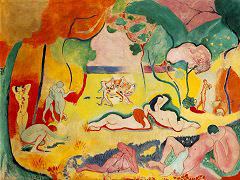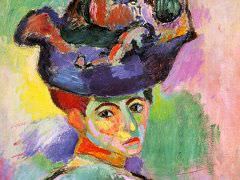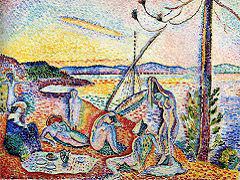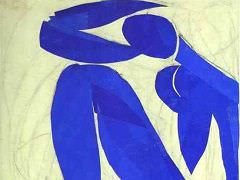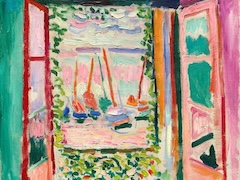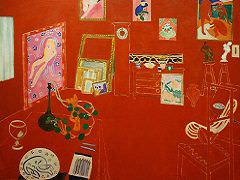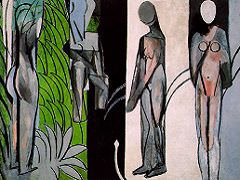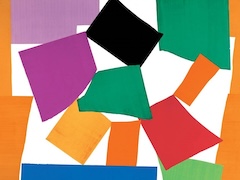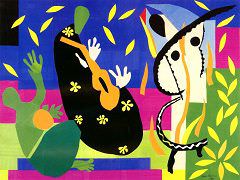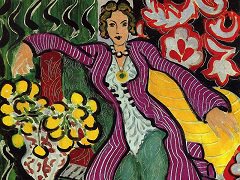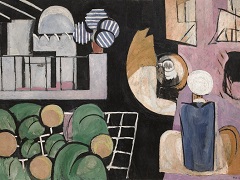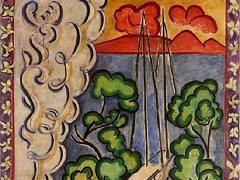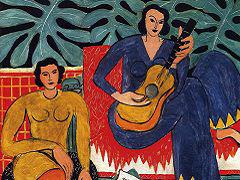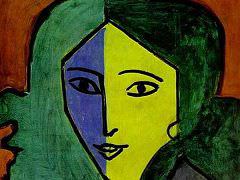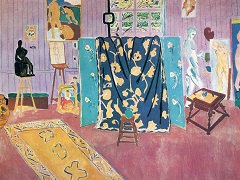Henri Matisse and Fauvism
Fauvism was the first of the avant-garde movements that flourished in France in the early years of the twentieth century. The Fauve painters were the first to break with Impressionism (leading artist: Claude Monet) as well as with older, traditional methods of perception. Their spontaneous, often subjective response to nature was expressed in bold, undisguised brushstrokes and high-keyed, vibrant colors directly from the tube.
Henri Matisse (French, 1869-1954) and André Derain (French, 1880-1954) introduced unnaturalistic color and vivid brushstrokes into their paintings in the summer of 1905, working together in the small fishing port of Collioure on the Mediterranean coast. When their pictures were exhibited later that year at the Salon d'Automne in Paris (Matisse, The Woman with a Hat), they inspired the witty critic Louis Vauxcelles to call them fauves ("wild beasts") in his review for the magazine Gil Blas. This term was later applied to the artists themselves.
The Fauves were a loosely shaped group of artists sharing a similar approach to nature, but they had no definitive program. Their leader was Henri Matisse, who had arrived at the Fauve style after earlier experimenting with the various Post-Impressionist styles of Vincent van Gogh, Gauguin, and Cézanne, and the Neo-Impressionism of Seurat, Cross, and Signac. These influences inspired him to reject traditional three-dimensional space and seek instead a new picture space defined by the movement of color planes, like painting The Young Sailor.
Another major Fauve was Maurice de Vlaminck (French, 1876-1958), who might be called a "natural" Fauve because his use of highly intense color corresponded to his own exuberant nature. Vlaminck took the final step toward embracing the Fauve style after seeing the second large retrospective exhibition of Van Gogh's work at the Salon des Indépendants in the spring of 1905, and the Fauve paintings produced by Matisse and Derain in Collioure.
As an artist, Derain occupied a place midway between the impetuous Vlaminck and the more controlled Matisse. He had worked with Vlaminck in Chatou, near Paris, intermittently from 1900 on ("School of Chatou"), and spent the summer of 1905 with Matisse in Collioure. In 1906-7, he also painted some twenty-nine scenes of London in a more restrained palette.
Other important Fauvists were Kees van Dongen, Charles Camoin, Henri-Charles Manguin, Othon Friesz, Jean Puy, Louis Valtat, and Georges Rouault. These were joined in 1906 by Georges Braque and Raoul Dufy.
For most of these artists, Fauvism was a transitional, learning stage. By 1908, a revived interest in Paul Cézanne's vision of the order and structure of nature had led many of them to reject the turbulent emotionalism of Fauvism in favor of the logic of Cubism. Braque became the cofounder with Picasso of Cubism. Derain, after a brief flirtation with Cubism, became a widely popular painter in a somewhat neoclassical manner. Matisse alone pursued the course he had pioneered, achieving a sophisticated balance between his own emotions and the world he painted.
The Fauvist movement has been compared to German Expressionism (leading artsts: Paul Klee, Wassily Kandinsky, and Gustav Klimt), both projecting brilliant colors and spontaneous brushwork, and indebted to the same late nineteenth-century sources, especially Van Gogh. The French were more concerned with the formal aspects of pictorial organization, while the German Expressionists were more emotionally involved in their subjects.

